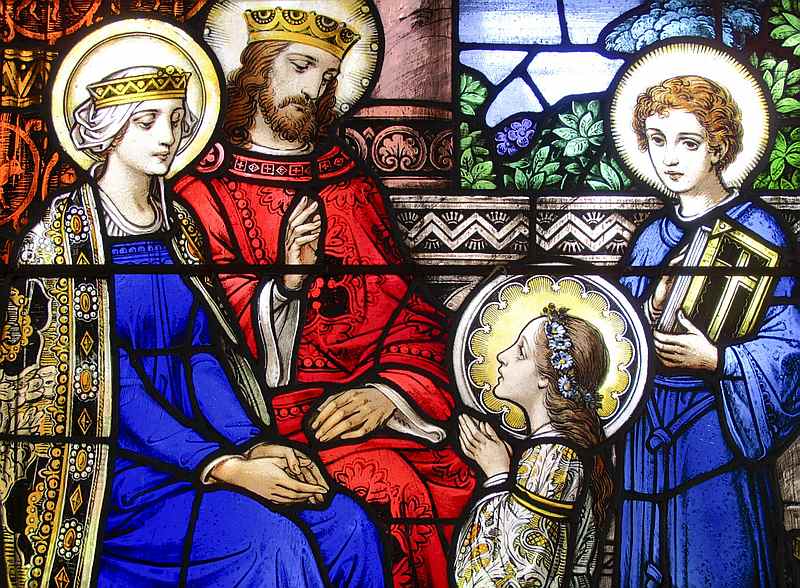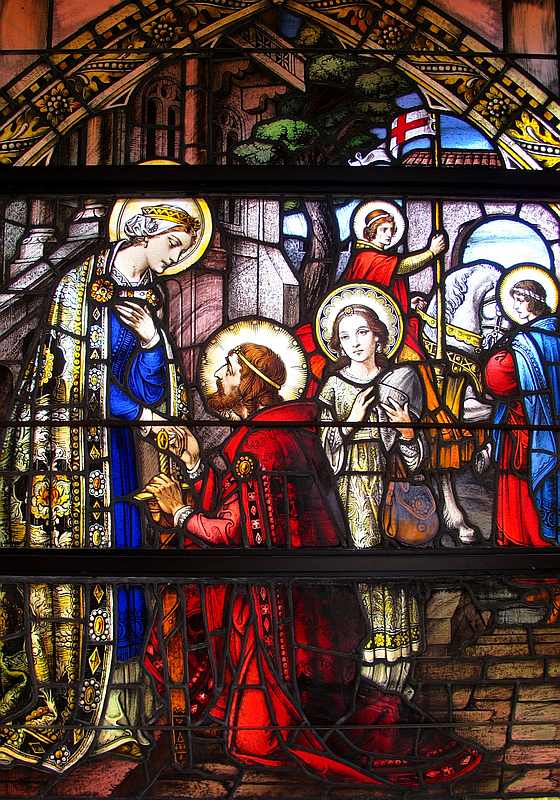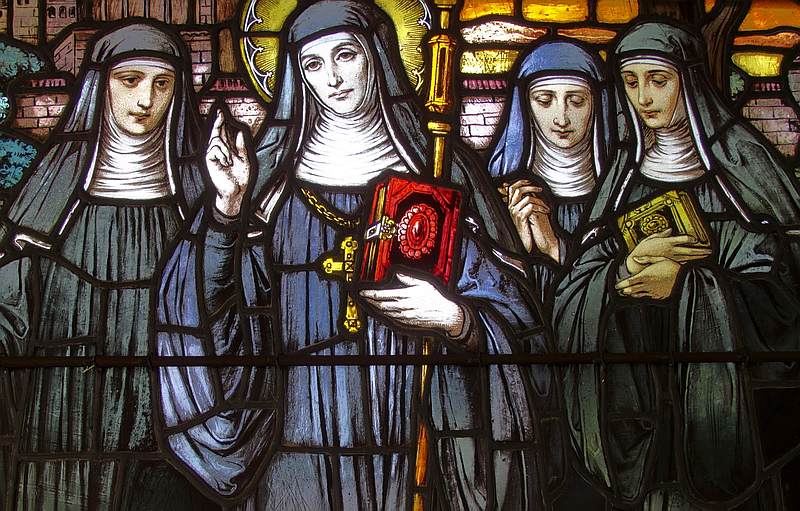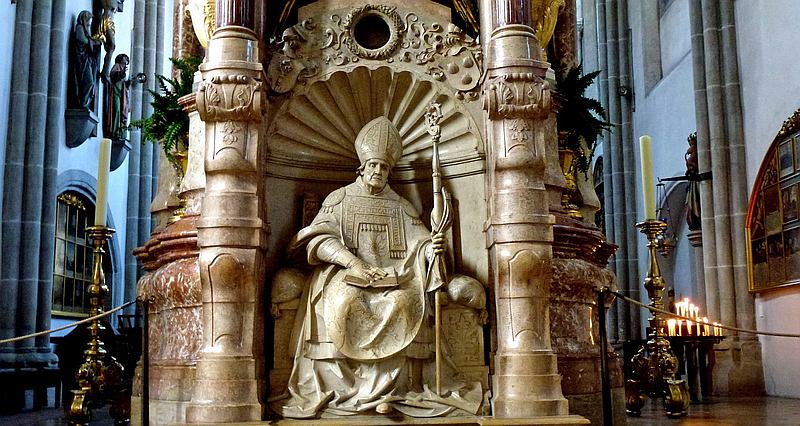

St. Willibald was son of the holy King St. Richard and his wife Bd. Wuna, and brother of St. Walburga. He was born about the year 704 in the Kingdom of the West-Saxons (in England), about the place where Southampton now stands. When he was three years old his life was despaired of in a violent sickness; but when all natural remedies proved unsuccessful, his parents carried him and laid him at the foot of a great cross which was erected in a public place near their house, according to the custom in Catholic countries to this day. There they poured forth their prayers with great fervor, and made a promise to God that in case the child recovered they would consecrate him to the divine service. God accepted their pious offering, and the child was immediately restored to health. St. Richard kept the child two years longer at home, but only regarded him as a sacred deposit committed to him by God; and when he was five years old placed him under the Abbot Egbald, and other holy tutors in the monastery of Waltheim. The young saint, from the first use of his reason, in all his thoughts and actions seemed to aspire only to Heaven, and his heart seemed full only of God and His holy love. He left this monastery about the year 721, when he was seventeen years old, and his brother St. Wunibald nineteen, to accompany his father and brother in a pilgrimage of devotion to the tombs of the Apostles at Rome, and to the Holy Land. They visited many churches in France on their road; but St. Richard died at Lucca, where his relics are still venerated in the church of St. Fridian, and he is commemorated in the Roman Martyrology on the 7th of February. The two sons went on to Rome, and there took the monastic habit.
 About two years after this, St. Wunibald having been obliged to return to England, St. Willibald set out,
with two or three young Englishmen, to visit the holy places which Christ had sanctified by His sacred presence on earth.
They added most severe mortifications to the incredible fatigues of their journey, living only on bread and water,
and at land using no other bed than the bare ground. They sailed first to Cyprus and thence into Syria. At Emesa
(now known as Homs), St. Willibald was taken by the Saracens for a spy, put in irons, and suffered much in
severe confinement for several months, till certain persons, who were charmed with his wonderful virtue, and moved
with compassion for his disaster, satisfied the caliph of his innocence, and procured his freedom. The holy pilgrims
expressed their gratitude to their benefactors, and pursued their journey to the holy places.
About two years after this, St. Wunibald having been obliged to return to England, St. Willibald set out,
with two or three young Englishmen, to visit the holy places which Christ had sanctified by His sacred presence on earth.
They added most severe mortifications to the incredible fatigues of their journey, living only on bread and water,
and at land using no other bed than the bare ground. They sailed first to Cyprus and thence into Syria. At Emesa
(now known as Homs), St. Willibald was taken by the Saracens for a spy, put in irons, and suffered much in
severe confinement for several months, till certain persons, who were charmed with his wonderful virtue, and moved
with compassion for his disaster, satisfied the caliph of his innocence, and procured his freedom. The holy pilgrims
expressed their gratitude to their benefactors, and pursued their journey to the holy places.
They resolved in visiting them to follow our Divine Redeemer in the course of His mortal life; and therefore they began their devotions at Nazareth. Our saint passed there some days with his companions in the continual contemplation of the infinite mercies of God, shown in the great Mystery of the Incarnation; and the sight of the place in which it was wrought drew from his eyes streams of devout tears during all the time of his stay in that town. From Nazareth he went to Bethlehem, and thence into Egypt, making no account of the fatigues and hardships of his journey, and assiduously meditating on what our Blessed Redeemer had suffered in the same. He returned to Nazareth, and thence travelled to Cana, Capharnaum, and Jerusalem. In this last place he made a long stay to satisfy his fervor in adoring Christ in the places where He wrought so many great mysteries, particularly on the mountains of Calvary and Olivet, the theaters of His sacred Death and Ascension. He likewise visited all the famous monasteries and hermitages in that country, with an ardent desire of learning and imitating all the most perfect practices of virtue, and whatever might seem most conducive to the sanctification of his soul. The tender and lively sentiments of devotion with which his fervent contemplation on the holy mysteries of our Redemption inspired him at the sight of all those sacred places, filled his devout soul with heavenly consolations, and made on it strong and lasting impressions. In his return a severe sickness at Acon (also known as Acre, Acco, Ptolemais, and by other names) exercised his patience and resignation. After seven years employed in this pilgrimage he arrived safe with his companions in Italy.
The celebrated monastery of Monte Cassino having been lately repaired by Pope Gregory II, the saint chose that house for his residence, and his fervent example contributed very much to settle in it the primitive spirit of its holy institute during the ten years that he lived there. He was first appointed sacristan, afterwards dean or superior over ten monks, and during the last eight years porter, which was an office of great trust and importance, and required a rooted habit of virtue which might suffer no abatement by external employments and frequent commerce with seculars.
It happened that in 738, St. Boniface, coming to Rome, begged of Pope Gregory III that St. Willibald, who was his cousin, might be sent to assist him in his missions in Germany. The Pope desired to see the monk, and was much delighted with the history of his travels, and edified with his virtue. In the close of their conversation, he acquainted him of Bishop Boniface's request. St. Willibald desired to go back at least to obtain the leave and blessing of his abbot; but the Pope told him his order sufficed, and commanded him to go without more ado into Germany. The saint replied that he was ready to go wheresoever His Holiness should think fit. Accordingly he set out for Thuringia, where St. Boniface then was, by whom he was ordained priest. His labors in the country about Eichstätt, in Franconia and Bavaria, were crowned with incredible success, and he was no less powerful in words than in works. He converted a great many pagans to the Catholic Faith, but unfortunately, we know not how many.
In 746 he was consecrated by St. Boniface Bishop of Eichstätt. This dignity gave his humility much to suffer, but it exceedingly excited his zeal. The cultivation of so rough a vineyard was a laborious and painful task; but his heroic patience and invincible meekness overcame all difficulties. His charity was most tender and compassionate, and he had a singular talent in comforting the afflicted. He founded a monastery which resembled in discipline that of Monte Cassino, to which he often retired. But his love of solitude diminished not his pastoral solicitude for his flock. He was attentive to all their spiritual necessities, he visited often every part of his charge, and instructed all his people with indefatigable zeal and charity. His fasts were most austere, nor did he allow himself any indulgence in them or in his labors on account of his great age, till his strength was entirely exhausted.
 A short biography of St. Willibald was written by a nun of his sister St. Walburga's monastery
(although some claim it was written by St. Walburga herself. Perhaps it was a combined effort.)
She gives from the saint's own relation a curious and useful description of the Holy Land, as it stood in that age.
Known as the Hodoeporicon of St. Willibald, it is the only existing account of a pilgrimage to the Holy Land made
in the eighth century, and is considered one of the earliest
A short biography of St. Willibald was written by a nun of his sister St. Walburga's monastery
(although some claim it was written by St. Walburga herself. Perhaps it was a combined effort.)
She gives from the saint's own relation a curious and useful description of the Holy Land, as it stood in that age.
Known as the Hodoeporicon of St. Willibald, it is the only existing account of a pilgrimage to the Holy Land made
in the eighth century, and is considered one of the earliest travel guides.
A short excerpt shows that the
author occasionally slipped from third person pronouns to the first person – an indication that St. Willibald was
dictating the information himself, or perhaps answering his sister's questions:
Then they went to Bethsaida, the native place of Peter and Andrew. A church now occupies the site where their home once stood. They passed the night there, and on the following morning set off for Corazain, where Our Lord cured the man possessed of the devil and drove the demons into a herd of swine. A church stands there now. After praying there, they departed and came to the spot where two fountains, Jor and Dan, spring from the earth and then pour down the mountainside to form the river Jordan. There, between the two fountains, they passed the night, and the shepherds gave us sour milk to drink. At this spot there are wonderful herds of cattle, long in the back and short in the leg, bearing enormous horns; they are all of one color, dark red. Deep marshes lie there, and in the summertime, when the great heat of the sun scorches the earth, the herds betake themselves to the marshes and, plunging themselves up to their necks in the water, leave only their heads showing.
Having labored almost forty-five years in regulating and sanctifying his diocese, he died at Eichstätt on the 7th of June, 790, being eighty-seven years old. He was honored with miracles, and buried in his own cathedral. Pope Leo VII canonized him in 938. In 1270 the Bishop Hildebrand built a church in his honor, into which his relics were translated, and are honorably preserved to this day; but a portion is honored at Furnec (now known as Veurne) in Flanders (Belgium).

NEW: Alphabetical Index
Contact us: smr@salvemariaregina.info
Visit also: www.marienfried.com